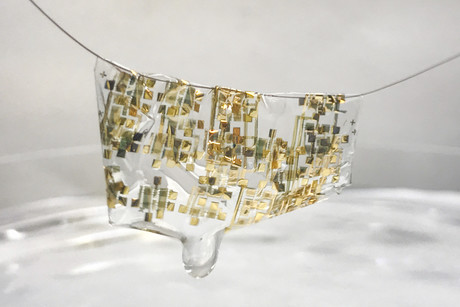Flexible, organic and biodegradable: electronics based on human skin

US researchers have developed a semiconductor that is as flexible as skin and easily degradable, offering diverse medical and environmental applications without adding to the mounting pile of global electronic waste. Their breakthrough has been published in Proceedings of the National Academy of Sciences.
For some time now, Stanford engineer Zhenan Bao and her team have been seeking to develop electronic devices that mimic the function of human skin. She noted that skin is stretchable, self-healable and also biodegradable — an attractive list of characteristics for electronics.
“We have achieved the first two, so the biodegradability was something we wanted to tackle,” she said.
Bao had previously created a stretchable electrode modelled on human skin — a material that could bend and twist in a way that could allow it to interface with the skin or brain, but couldn’t degrade. That limited its application for implantable devices and unfortunately contributed to waste.
Creating a robust material that is both a good electrical conductor and biodegradable was a challenge, said Bao, considering traditional polymer chemistry. Eventually, the team found that by tweaking the chemical structure of the flexible material it would break apart under mild stressors.
“We came up with an idea of making these molecules using a special type of chemical linkage that can retain the ability for the electron to smoothly transport along the molecule,” Bao said. “But also this chemical bond is sensitive to weak acid — even weaker than pure vinegar.”
The result was a flexible, conductive plastic material that could carry an electronic signal but break down without requiring extreme measures. As noted by Ting Lei, lead author on the study, “This is the first example of a semiconductive polymer that can decompose.”
In addition to the polymer, the team developed a new type of electrical component and a substrate material that attaches to the entire electronic component, flexing and moulding to rough and smooth surfaces alike. They crafted their component from iron — an environmentally friendly product that is non-toxic to humans — while the substrate was created from cellulose — the same substance that makes up paper. These cellulose fibres were then altered so the ‘paper’ is transparent and flexible while still breaking down easily.

The combination of a biodegradable conductive polymer and substrate makes the electronic device useful in a plethora of settings — from wearable electronics to large-scale environmental surveys with sensor dusts.
“We envision these soft patches that are very thin and conformable to the skin that can measure blood pressure, glucose value, sweat content,” said Bao, suggesting that a person could wear a specifically designed patch for a day or week, then download the data. She added that this short-term use of disposable electronics would be a good fit for a degradable, flexible design.
The components could also be used in places where surveys cover large areas in remote locations, with Lei suggesting they may be dropped by plane over a forest to survey the landscape.
“It’s a very large area and very hard for people to spread the sensors,” he said. “Also, if you spread the sensors, it’s very hard to gather them back. You don’t want to contaminate the environment, so we need something that can be decomposed.”
Furthermore, the biodegradable substrate, polymers and iron electrodes make the entire component compatible with insertion into the human body, with the polymer breaking down to product concentrations lower than the published acceptable levels found in drinking water. And while Bao said more studies will need to be done before implants are a regular occurrence, she is ultimately hopeful that biodegradable electronics will play an important role in the future of e-waste management.
Unlocking next-gen chip efficiency
By studying how heat moves through ultra-thin metal layers, researchers have provided a...
Ancient, 3D paper art helps shape modern wireless tech
Researchers have used ancient 3D paper art, known as kirigami, to create tuneable radio antennas...
Hidden semiconductor activity spotted by researchers
Researchers have discovered that the material that a semiconductor chip device is built on,...






